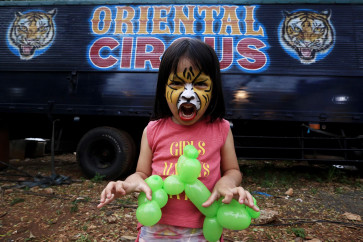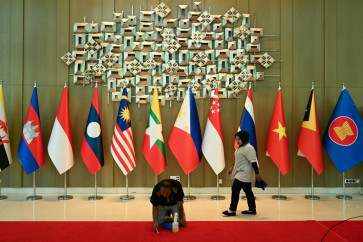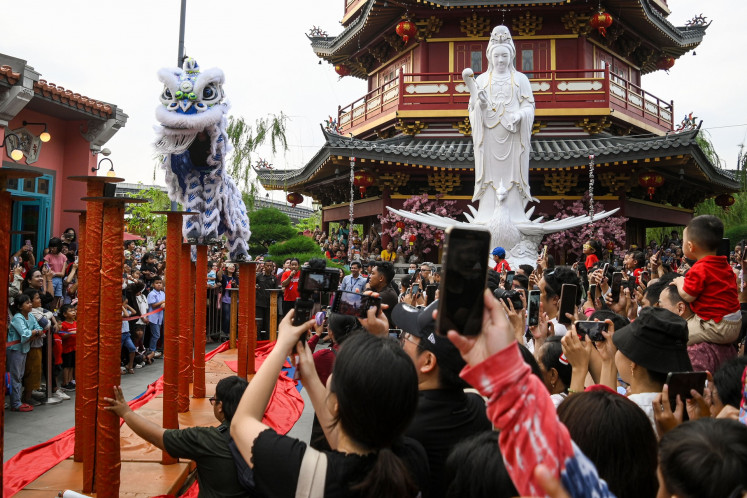Bali Fashion Week looks to brighter future
Models sporting branded casual jeans and tank-tops strutted down the bar table-come-catwalk at the final event for Bali Fashion Week 2008 at the Hard Rock Hotel's Center Stage in Kuta, late Friday
Change text size
Gift Premium Articles
to Anyone

Models sporting branded casual jeans and tank-tops strutted down the bar table-come-catwalk at the final event for Bali Fashion Week 2008 at the Hard Rock Hotel's Center Stage in Kuta, late Friday.
Sexy swim wear and sensuous lingerie collections were followed by musical performances by Siluet and the Rice Girls (a new group of singers from Australia) during the intervals.
It was a fairly lackadaisical evening compared to the past four days of brave colors and elegant dresses which filled Bali Fashion Week this year. Nevertheless it did serve as a reminder for Mardiani Ika, the creator of Bali Fashion Week, that another year had passed and it was now time for everyone to concentrate on the future.
"I know that those who came out and worked hard to make their designs for display made a lot of connections with people in the industry and even got some orders," Ika told The Jakarta Post, standing next to the pool outside away from the Techno-music blaring from Center Stage.
"Of course, it could have been better but I believe, given our capacity, that it was the best show we could have done," Ika said.
Ika has been the driving force behind Bali Fashion Week since its inception in 2000. Now it has become an annual international trade event which serves as a platform for buyers and sellers to meet and discuss potential business relationships.
This year Bali Fashion Week was organized by the ModaBali foundation. The show presented 50 both well-known and rising designers from 35 countries, such as Doii, a Korean-born designer based in Paris; Hu SheGuang who has designed clothes for the Queen of Holland; Mich Dulce from the Philippines; Selphie Bong, who has been called the Indonesian Christian-Dior-to-be; and the famous Indonesian designer Oka Diputra.
Ika said this year's theme was derived from the Balinese philosophy Tri Hita Karana (harmony between God, human beings and the environment) -- a tough challenge for designers.
"It is hard for the industry to support this kind of movement because, for example, recycled fabrics cost twice as much," Ika said.
"However, the event had reached its goal -- to introduce a "greener" trend among fashion industry people."
"I know I won't see recycled fabrics or garments in the fashion industry any time soon, but I feel this show has at least put that idea into the minds of those who were here. And I have to say, I'm very happy and again very proud," Ika added.
In lieu with this year's theme of fashion meets nature, a street carnival of designs exuding both ambitious and ephemeral qualities started the week off last Sunday with models showing off dresses made with natural and recycled elements.
Models appeared on horse-drawn carriages from Jl. Melasti to Jl. Legian and then on to Jl. Pantai Kuta, adorned in dresses of leaves, twigs and golden wrapping paper (normally used for prayer).
Performers strolled beside and accompanied models, performing the Kecak dance and the Kuda Lumping (bamboo horses with men astride), as they entertained the thousands of onlookers who lined Kuta beach.
Three days of fashion shows followed at the Garuda Wisnu Kencana building -- each a display of what designers could do with environmentally friendly materials and natural themes.
Floral motifs dominated Junie Kwanda's designs. Her collection of 12 dresses, called Lolita Harajuku were bright (to say the least) with pinks, blues, reds, white and yellows lighting up the models with a cheeky aura.
Balinese designer Muji Ananta, meanwhile, attempted to portray strength with his Sea-Shell-themed collection. Dark colors gave the designs a batik feeling, and serrated sewing added a daring tone to his work.
A relatively new designer to Bali Fashion Week, Fabio Renaldo from Bandung, West Java, took a different approach and introduced ready-to-wear dresses in which fabric was made from natural fibers using a fermentation process.
For Fabio, this year's fashion week theme struck a chord.
"I've always been very concerned about the environment and waste management, and I think this event is perfect because it's not just about giving new fashion designers access to the industry, but also serves as a campaign for eco-design," he told the Post.
Fabio shared Ika's view that it would take a long time for the fashion industry to become more environmentally friendly, but remained optimistic that this would occur.
"For the fashion industry to change, designers need not only to set trends, but also lifestyles," he said.
"And from what I saw at this event, many designers have already looked for ways to go into that direction. So it's just a matter of time I think," he said.
So what's next for Bali Fashion Week?
"I don't know," said Ika, who was planning on working with Indonesian fashion designers in small and medium enterprises once this year's fashion week concludes.
"As long as up-and-coming fashion designers need help with access to the industry, there will always be Bali Fashion Week," she said.









